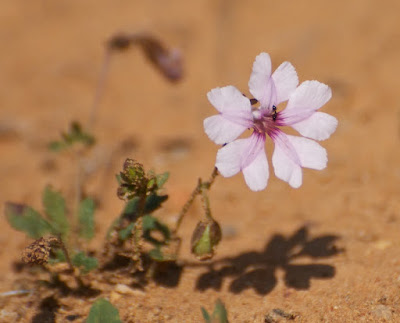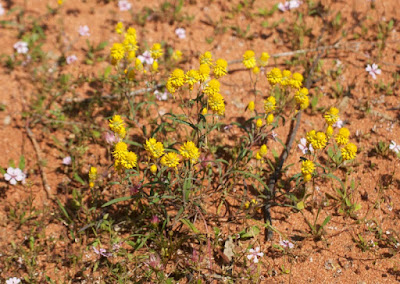The road east carried us to the edge of Australia's celebrated 'Red Centre', named for its iron-stained soils.
Here we encountered occasional flocks of corellas. Out here they could be Little Corellas (Cacatua sanguinea), a largely eastern and central Australian species becoming increasingly common in the southwest, or the increasingly rare Western Corella (Cacatua pastinator). Little Corellas prefer drier country than Westerns, but there is a lot of overlap and birders (like me) eager to see Westerns have to be careful (and skeptical). These, though, appear to be genuine Westerns - note the long, pointed upper mandible, quite unlike the much stubbier bill of the Little Corella - though in this part of Australia the two species may interbreed.
As we drove east, the road passed through one of the most significant Australian landmarks. A post-and-wire fence may not seem particularly noteworthy. This, though, is not just any fence: it is the famous No. 2 Rabbit-Proof Fence, a symbol - among other things - of man's environmental folly, and the difficulty and expense of putting a genie back in its bottle once it has been, unwisely, released.
Ironically, considering the enormous sums that have had to have been spent in their control, rabbits (the European Rabbit, Oryctolagus cuniculus) were first introduced to Australia deliberately; a farmer released some on his property back in 1859, and others were brought in as pets or game animals.
The rabbit-proof fence is a symbol of more than just our incomprehension of nature. It also plays a role in the story of Australian colonists' mistreatment of the continent's own native peoples. The story is told in the beautiful film Rabbit-Proof Fence, based on a true tale of two young aboriginal girls that escaped from a government-operated residential school designed (much as were our shameful residential schools in Canada) to forcibly remove "half-breed" children from their families and train them for careers as, mostly, domestics. The girls used the fence, successfully, as a guide to lead them northward to their real homes. Eileen had found the film almost overwhelmingly moving (if you haven't seen it, you should), and a stop to see the thing itself was mandatory.
Past the line of the rabbit-proof fence, the landscape could not have been more different from the densely-vegetated Kwongan: bare ground amid scattered trees, dotted with ephemeral spring flowers.
Here, the bulk of the flowers were of a single species (but, fortunately, a lovely one): Pink Velleia (Velleia rosea), another of the Goodeniaceae.
The plants here tend to be inland species at the western edge of their range, rather than heathland plants local to the area or extending down around the southwest coast. From here, Pink Velleia ranges not south but east, out towards the desert city of Kalgoorlie.
Keraudrenia belongs to the mallow family (Malvaceae). It has an odd distribution: the eight species are found, taken together, in Australia, new Guinea and - oddly - Madagascar. This is probably Common Firebush (K. integrifolia).
The daisy or composite family (Asteraceae) is a source of dry-country ephemerals - annual plants that bloom briefly, often in enormous numbers, after spring rains, live for only a few weeks, and cast out seeds that lie dormant in the sand until the next brief rainy season - in many parts of the world. In this part of Australia the most notable of the Asteraceae are the stiff-flowered, white or pink everlastings; here, though, we found another attractive species, the Orange Immortelle (Waitzia acuminata).
Rosy Bellida (Bellida graminea) is another composite, the only member of its genus.
The area around the rabbit-proof fence was really only a stop-off, a brief introduction to our day. To plan the rest, we headed south to Perenjori, which advertises itself as a centre for wildflower tourism...
...dropped in briefly at the Visitors' Centre...
... and set our course eastward. The oddly-named Camel Soak was our next stop - and what we saw there will be the subject of my next post.























because you just couldn't make it up without having it seem too far-fetched! A sad, moving, but often inspirational film.iron gate
ReplyDelete